A miniature is a small-scale reproduction, or a small version. It may refer to:
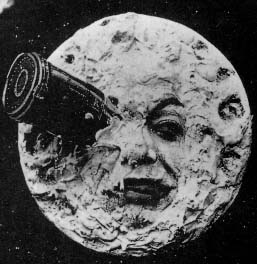
A miniature effect is a special effect created for motion pictures and television programs using scale models. Scale models are often combined with high speed photography or matte shots to make gravitational and other effects appear convincing to the viewer. The use of miniatures has largely been superseded by computer-generated imagery in contemporary cinema.
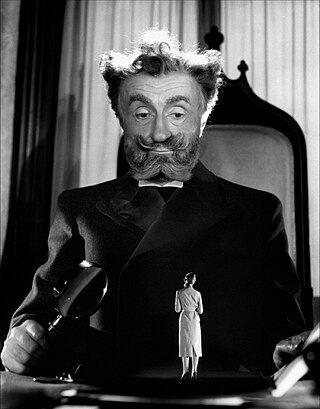
Special effects are illusions or visual tricks used in the theatre, film, television, video game, amusement park and simulator industries to simulate the imagined events in a story or virtual world. It is sometimes abbreviated as SFX, but this may also refer to sound effects.

In art, chiaroscuro is the use of strong contrasts between light and dark, usually bold contrasts affecting a whole composition. It is also a technical term used by artists and art historians for the use of contrasts of light to achieve a sense of volume in modelling three-dimensional objects and figures. Similar effects in cinema, and black and white and low-key photography, are also called chiaroscuro. Taken to its extreme, the use of shadow and contrast to focus strongly on the subject of a painting is called tenebrism.
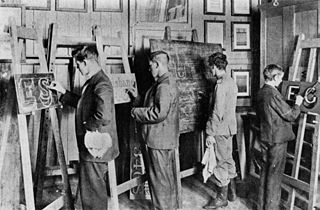
An easel is an upright support used for displaying and/or fixing something resting upon it, at an angle of about 20° to the vertical. In particular, painters traditionally use an easel to support a painting while they work on it, normally standing up; easels are also sometimes used to display finished paintings. Artists' easels are still typically made of wood, in functional designs that have changed little for centuries, or even millennia, though new materials and designs exist. Easels are typically made from wood, aluminum or steel.
Visual effects is the process by which imagery is created or manipulated outside the context of a live-action shot in filmmaking and video production. The integration of live-action footage and other live-action footage or CGI elements to create realistic imagery is called VFX.

The Schüfftan process is a special effect in filmmaking named after its inventor, German cinematographer Eugen Schüfftan (1893–1977). The technique consists of covering part of the camera's view with a mirror, allowing filmmakers to assemble an image from multiple parts. It was widely used in the first half of the 20th century before being almost completely replaced by the travelling matte and bluescreen effects.

A portrait miniature is a miniature portrait painting from Renaissance art, usually executed in gouache, watercolor, or enamel. Portrait miniatures developed out of the techniques of the miniatures in illuminated manuscripts, and were popular among 16th-century elites, mainly in England and France, and spread across the rest of Europe from the middle of the 18th century, remaining highly popular until the development of daguerreotypes and photography in the mid-19th century. They were usually intimate gifts given within the family, or by hopeful males in courtship, but some rulers, such as James I of England, gave large numbers as diplomatic or political gifts. They were especially likely to be painted when a family member was going to be absent for significant periods, whether a husband or son going to war or emigrating, or a daughter getting married.

A miniature is a small illustration used to decorate an ancient or medieval illuminated manuscript; the simple illustrations of the early codices having been miniated or delineated with that pigment. The generally small scale of such medieval pictures has led to etymological confusion with minuteness and to its application to small paintings, especially portrait miniatures, which did however grow from the same tradition and at least initially used similar techniques.

Mattes are used in photography and special effects filmmaking to combine two or more image elements into a single, final image. Usually, mattes are used to combine a foreground image with a background image. In this case, the matte is the background painting. In film and stage, mattes can be physically huge sections of painted canvas, portraying large scenic expanses of landscapes.
This article contains a list of cinematic techniques that are divided into categories and briefly described.

A bird's-eye view is an elevated view of an object or location from a very steep viewing angle, creating a perspective as if the observer were a bird in flight looking downward. Bird's-eye views can be an aerial photograph, but also a drawing, and are often used in the making of blueprints, floor plans and maps.

In cinematography, bipacking, or a bipack, is the process of loading two reels of film into a camera, so that they both pass through the camera gate together. It was used both for in-camera effects and as an early subtractive colour process.
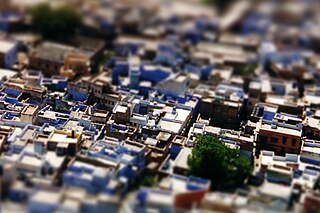
Miniature faking, also known as diorama effect or diorama illusion, is a process in which a photograph of a life-size location or object is made to look like a photograph of a miniature scale model. Blurring parts of the photo simulates the shallow depth of field normally encountered in close-up photography, making the scene seem much smaller than it actually is; the blurring can be done either optically when the photograph is taken, or by digital postprocessing. Many diorama effect photographs are taken from a high angle to simulate the effect of looking down on a miniature. Tilt–shift photography is also associated with miniature faking.

Craig Barron is an American visual effects artist and creative director at Magnopus, a media company that produces visual development and virtual production services for motion pictures, television, museums and multimedia platforms.

Dead Eagle Owl is an 1881 oil-on-canvas painting by Édouard Manet. One of the very few hunting still lifes in Manet's oeuvre, it depicts a dead Eurasian eagle-owl hanging upside down on a board as a hunting trophy. Dead Eagle Owl is one of a series of comparable still lifes that Manet painted in the same year in Versailles, during his recuperation from a serious illness. There are precedents for this morbid work in French still-life painting of the 18th century and Dutch still-life painting of the 17th century. The painting is in the collection of the Foundation E.G. Bührle in Zürich.
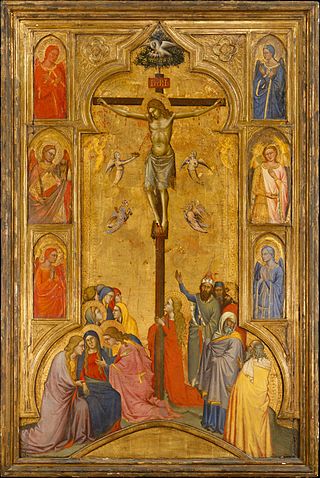
Gold ground or gold-ground (adjective) is a term in art history for a style of images with all or most of the background in a solid gold colour. Historically, real gold leaf has normally been used, giving a luxurious appearance. The style has been used in several periods and places, but is especially associated with Byzantine and medieval art in mosaic, illuminated manuscripts and panel paintings, where it was for many centuries the dominant style for some types of images, such as icons. For three-dimensional objects, the term is gilded or gold-plated.
The Empire Strikes Back is a 1980 American epic space opera film directed by Irvin Kershner, with a screenplay by Leigh Brackett and Lawrence Kasdan, based on a story by George Lucas. It is the sequel to Star Wars (1977), the second film in the Star Wars film series, and the fifth chronological chapter of the Skywalker Saga. Set three years after the events of Star Wars, its story follows the battle between the Galactic Empire led by Emperor Palpatine and the Rebel Alliance led by Princess Leia. Meanwhile, Luke Skywalker trains to master the Force so he can confront the Sith lord Darth Vader. The ensemble cast includes Mark Hamill, Harrison Ford, Carrie Fisher, Billy Dee Williams, Anthony Daniels, David Prowse, Kenny Baker, Peter Mayhew, and Frank Oz.
The special effects of the 1990 action film Total Recall were developed by visual-effects company Dream Quest Images, with contributions by Stetson Visual Services, Metrolight Studios, and Industrial Light & Magic. Over 100 visual effects were produced for the film, which relied almost entirely on practical effects at a time when computer-generated imagery was a new and rarely-used technique.
The special effects of the 1991 American science fiction action film Terminator 2: Judgment Day were developed by four core groups: Industrial Light & Magic (ILM), Stan Winston Studio, Fantasy II Film Effects, and 4-Ward Productions. Pacific Data Images and Video Images provided some additional effects.













